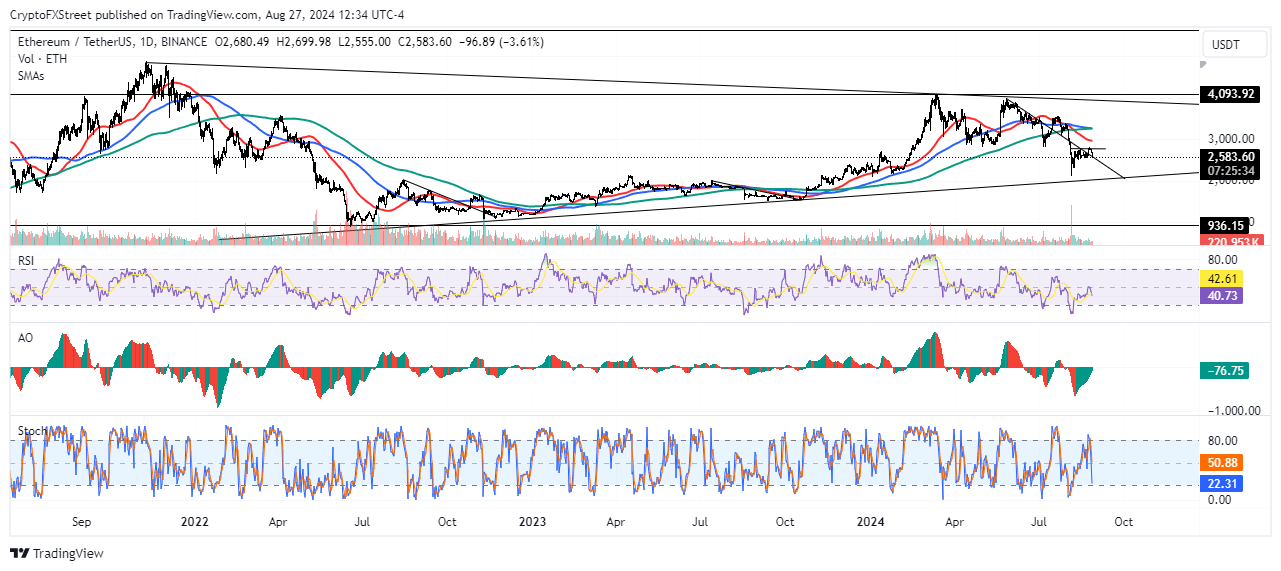Ethereum dives 4% as whales and ETF investors shed their holdings
- Traditional investors are on a selling spree as ETH ETFs extend their outflow streak to eight days of consecutive negative flows.
- Whales are also dumping ETH heavily following its recent price decline.
- Vitalik Buterin holds 90% of his net worth in ETH.
- Ethereum is attempting to move below a key trendline that suggests further price decline amid mixed signals across technical indicators.
Ethereum (ETH) is down nearly 4% on Tuesday following increased selling pressure from ETH ETF investors and whales. The selling pressure has also led to Ethereum co-founder Vitalik Buterin being accused of not believing in ETH as a store of value (SoV).
Daily digest market movers: Ethereum ETF outflow streak, whales sell pressure, Vitalik Buterin's net worth
Ethereum ETF investors have yet to stop shedding their holdings after the products posted net outflows of $13.2 million on Monday, per Farside Investors' data. As a result, ETH ETFs have stretched their negative flow streak to eight consecutive days of net outflows.
Unlike previous days, where Grayscale's ETHE outflows outweighed inflows from other issuers, none of the new eight ETH ETFs recorded inflows. Fidelity's FETH, Franklin's EZET and Grayscale's ETHE saw outflows of $2.7 million, $1 million and $9.5 million, respectively.
A similar trend is occurring among investors within the traditional crypto market, where several whales have potentially been dumping ETH by depositing on centralized exchanges in the past few hours, according to data from Lookonchain:
- A whale who withdrew 5,088 ETH worth $17.24M from Binance at $3,389 sold all of his holdings for $13.58M with a total loss of $3.66M.
- Two whales that were about to be liquidated on Aave sold a combined 8,208 ETH worth $21.59M.
- Another whale requested to unstake 30,000 ETH. The whale claimed and deposited 19,000 ETH worth $49.17M to Binance for a potential sale.
- Shortly after, another whale exchanged 4,591.8 stETH for 4,589.5 ETH at a loss of 2.3 ETH to avoid the withdrawal queue. The whale eventually deposited 5,145 ETH worth $13.3M to Binance.
Following the heavy selling pressure, several crypto community members have accused Ethereum co-founder Vitalik Buterin and core developers of not believing in ETH as a store of value (SoV). However, Buterin refuted the claims, stating he holds 90% of his net worth in ETH.
If I did not believe in ETH as SOV I would not hold ∼90% of my net worth in it.
— vitalik.eth (@VitalikButerin) August 27, 2024
ETH technical analysis: Ethereum falls below key trendline as indicators signal mixed sentiment
Ethereum is trading around $3,580 on Tuesday, down 4% on the day. In the past 24 hours, ETH has seen over $48 million in total liquidations — the largest in the crypto market. The recent price decline liquidated several long positions worth $46.46 million, while shorts saw only $1.8 million in liquidations.
Ethereum is attempting to descend below a key trendline that suggests its price could test the lower ascending trendline of a key triangle. Such a move could see ETH finding support around the $2,000 to $2,300 range before staging a rally.

ETH/USDT Daily chart
ETH posted similar declines from August 2022 to November 2022 and July 2023 to October 2023 before rallying on both occasions. If ETH completes this move, it could attempt to tackle the upper descending trendline of the triangle and eventually challenge its yearly high of $4,093.
The Relative Strength Index (RSI) crossed below its moving average on Monday, indicating bearish momentum.
After posting a bearish signal when its %K line crossed below its %D line around the overbought region, the Stochastic Oscillator (Stoch) is signaling prevailing bearish momentum at 22. A move into the oversold region below 20 could indicate a potential buying opportunity.
The Awesome Oscillator (AO) continues to post consecutive smaller green bars below the zero line. A continuation of this move could signal weakening bearish pressure.
The thesis will be invalidated if ETH breaches the lower ascending trendline of the triangle.
Ethereum FAQs
Ethereum is a decentralized open-source blockchain with smart contracts functionality. Serving as the basal network for the Ether (ETH) cryptocurrency, it is the second largest crypto and largest altcoin by market capitalization. The Ethereum network is tailored for scalability, programmability, security, and decentralization, attributes that make it popular among developers.
Ethereum uses decentralized blockchain technology, where developers can build and deploy applications that are independent of the central authority. To make this easier, the network has a programming language in place, which helps users create self-executing smart contracts. A smart contract is basically a code that can be verified and allows inter-user transactions.
Staking is a process where investors grow their portfolios by locking their assets for a specified duration instead of selling them. It is used by most blockchains, especially the ones that employ Proof-of-Stake (PoS) mechanism, with users earning rewards as an incentive for committing their tokens. For most long-term cryptocurrency holders, staking is a strategy to make passive income from your assets, putting them to work in exchange for reward generation.
Ethereum transitioned from a Proof-of-Work (PoW) to a Proof-of-Stake (PoS) mechanism in an event christened “The Merge.” The transformation came as the network wanted to achieve more security, cut down on energy consumption by 99.95%, and execute new scaling solutions with a possible threshold of 100,000 transactions per second. With PoS, there are less entry barriers for miners considering the reduced energy demands.

